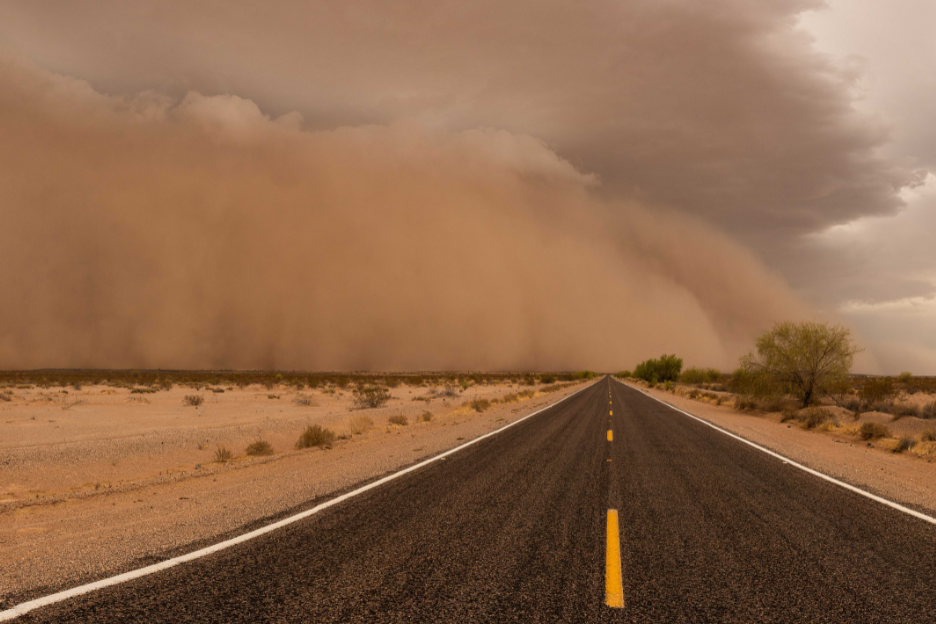
When Arizona natives say they can smell a thunderstorm, they aren’t exaggerating. The low pressure from an approaching storm triggers a reaction from the creosote bush, giving the air a sweet, earthy smell. It can also be a warning of something else, though: the potential for a haboob.
Haboobs, or dust storms, can blow up with little warning. They can be miles high and hundreds of miles wide. Their wind speeds rival that of any snowstorm in the north. When one strikes, it can cause extensive damage, accidents, and hospitalizations from dust inhalation.
Haboobs can be particularly dangerous for truck drivers. High winds and poor visibility both pose risks to big rigs. All that dust isn’t great for the gears, either. If your run takes you through Arizona, Nevada and New Mexico, understanding haboob safety is crucial to your job.
Here’s what you need to do if a haboob strikes.
What exactly is a haboob?
A haboob is a weather phenomenon that’s unique to arid desert regions like parts of the southwest. When a thunderstorm forms here, it often doesn’t cause a heavy rainfall. Instead, it can cause something much worse: a high-powered dust storm.
We’re going to get scientific for a minute, so bear with us: typically, in a thunderstorm, water droplets within the clouds condense, and fall to the earth as rain. When a thunderstorm appears over deserts and dry areas with low vegetation, though, something else happens. The heat from the ground causes the rain to evaporate, creating a fast current of cooling air instead. When this current hits the ground, it expands outward in a blast of rushing air, carrying dust and sand into the air. Presto, a haboob is born, and it brings mayhem, near-zero visibility and destruction with it.
While there’s often little warning of a haboob, you can still be prepared in case one strikes. Here’s what southwest truck drivers need to do if a haboob is approaching.
Be prepared and plan ahead. Haboobs can occur during the southwest monsoon season (yes, the southwest has a monsoon season). Between the months of June and September, keep close watch on the weather forecast. If thunderstorms are predicted, then there’s a risk of a haboob as well.
When you’re planning your route for the day, make note of every truck stop and safe place to stop. Haboobs can develop quickly, and you’ll need to know where you can safely park your rig. Which brings us to our next point:
Don’t try to outrun the storm! A haboob can move at speeds of 60 miles an hour. You can’t outrun that, especially if you’re hauling full. If a haboob is approaching, get off the road as soon as it is safely possible. Ideally, pull into a truck stop or parking lot and wait out the storm. If none are close by, though, get to the road’s shoulder instead. Put yourself in park, apply the emergency brake, and turn off your lights so no other motorists mistakenly believe you’re still moving.
Stay in your rig. Once you’ve parked, stay where you are – and with your seatbelt on. Don’t be tempted to make a sprint for the nearest building. Haboobs can move at shocking speed. People have lost their lives after becoming trapped outdoors during dust storms. Shelter in your truck until the storm has passed. Turn off your truck, turn off the AC and close all vents. This will prevent dust from getting inside the cab. Keep your radio on for updates on the storm.
After the storm, perform a circle check. Once the haboob passes, check your entire rig to see if it has sustained any damage.
If everything gets a green checkmark, you’re ready to roll. Almost…
Wait until the skies are clear. Haboobs can come in waves, and following winds can continue to carry dust around after they pass. It may also take time for the dust and debris to settle. There’s no point getting back on the road until that happens.
A good rule of thumb is to wait until visibility increases to 300 meters. If you can see that far ahead and you’ve found no problems during your circle check, it’s likely safe to continue on. Check the traffic report to see if there’s any accidents or road closures from the storm.
While haboobs can throw southwest truck drivers for a loop, they’re also relatively rare. You just need to be prepared for what to do if one strikes. We will say this: once the haboob passes, the “desert rain” smell of the creosote bush almost makes it worth it. Almost. Come join Truline and find out for yourself. Check out our current opportunities, and begin your Truline journey today.